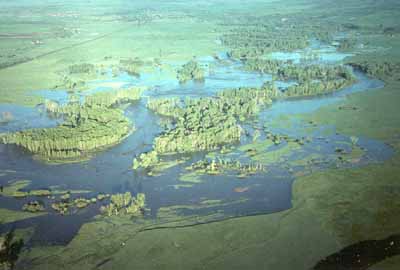Ecological Significance of Natural Flow Regimes
The natural flow paradigm springs from an understanding that aquatic and riparian organisms depend upon, or can tolerate, a range of flow conditions specific to each species. For example, certain fish species will move into floodplain areas during flood events to spawn, feed, or escape predation from other species occupying the main channel. If flooding occurs at the right time of the year, and lasts for the right amount of time, these fish populations will benefit from the flood event.
On the other hand, other species may be adversely affected by the same flood. For example, benthic (bottom-dwelling) macroinvertebrates may be scoured from the streambed or riparian trees may become stressed or die from prolonged flooding and associated oxygen deprivation. Also important is the rate at which flow levels change. If the river level rises too fast, it can trap animals such as amphibians and reptiles on the floodplain. Conversely, young plants such as cottonwoods taking root on the floodplain can die from moisture stress if their growing root systems cannot keep up with the dropping water table linked to falling river levels.
Natural low-flow conditions can be equally important. Prolonged natural droughts might help certain plants such as bald cypress trees become established on the floodplain, before river levels again rise up around their growing trunks. In the river channel, low flows will concentrate fish and other aquatic organisms, benefiting predators such as larger fish or wading birds. If low flows are too severe, or last for too long due to human influences, large numbers of individuals may perish and jeopardize the local populations of certain species.
Thus, rather than trying to prescribe a flow regime that benefits some species all of the time, a better approach is to restore or sustain a flow regime that benefits each species some of the time. The species that are found in each river have endured many trials of adverse flow conditions, exploited many occasions of favorable flow, and have managed to persist in their native rivers over long periods of time. Until very recently in evolutionary time, the variation in river flows has been dictated largely by natural climatic and environmental conditions. These natural river flows have influenced the development of behavioral (e.g., floodplain spawning), physiological (e.g., tolerance for oxygen deprivation), and morphological (e.g., body shape) traits in riverine species. Thus, perpetuation of the natural flow regime is the best approach for conserving the full richness of a river's biological diversity.
Flow regimes (explained in detail in Section 6) exert a strong influence on other ecosystem conditions as well. Water chemistry, temperature, nutrient cycling, oxygen availability, and the geomorphic processes that shape river channels and floodplains are often tightly coupled to streamflow variation. Natural flow regimes are therefore intimately linked to many different aspects of ecological integrity.
![[logo] US EPA](https://www.epa.gov/epafiles/images/logo_epaseal.gif)
